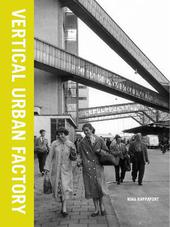
|
Vertical Urban Factory
Paperback / softback
Main Details
Description
This revised edition focuses on the spaces of production in cities-both the modernist period and today-and the technologies that have contributed to shifts in factory architecture, manufacturing, and urban design. Vertical Urban Factory tracks the evolution of the vertical urban factory from the first industrial revolution to the present and provides an analysis of the political, social, and economic factors that have shaped today's global industrial landscape. Ultimately, it provokes new concepts for the futureof urban manufacturing, and the necessity of creating new paradigms for sustainable, self-sufficient urban industry. Illustrated with historic and contemporary photographs, manufacturing process diagrams, and infographics by MGMT Design.
Author Biography
Nina Rappaport is an architectural critic, curator, historian, and educator. For over sixteen years she has been publications director at Yale School of Architecture, for which she edits the bi-annual magazine Constructs, exhibition catalogs, and the books series. She directs Vertical Urban Factory, which includes a traveling exhibition (New York, Detroit, Toronto, London, and Lausanne) and a think tank analyzing manufacturing, factory design, and ecological industrial urbanism. She curated the exhibitions Ezra Stoller: Photographer in Washington, D.C., The Swiss Section at the Van Alen Institute, in New York, and co-curated Saving Corporate Modernism, at Yale. She is co-editor of the book, Ezra Stoller: Photographer, author of the book, Support and Resist: Structural Engineers and Design Innovation, and co-author of the book, Long Island City: Connecting the Arts. She has taught industrial urbanism, urban design theory, and has co-taught architectures studios at Syracuse New York City, Parsons School of Design, Barnard College, City College, and Yale School of Architecture. She has written numerous essays on structural design, architecture, and global industrial landscapes for international journals and magazines.
ReviewsExceptionally well written, organized and presented, Vertical Urban Factory is an impressive work of seminal scholarship and an essential, core, and invaluable addition to professional, corporate, college, and university library Urban Studies collections and American Industrial Studies supplemental reading lists. --Carl Logan, Library Bookwatch Now that architects see nothing but a global culture of consumerism, they need to pay more attention to the factories that feed it. Critic, curator, educator Nina Rappaport encapsulates in this book several years of investigations in architecture studios, her extensive consultations, and her exhibitions devoted to the "architectural, social, and spatial typologies" of factories since the rise of modern production around 1800. --C. W. Westfall, University of Notre Dame, Choice (American Library Association) Rappaport describes the innovations in architecture, engineering, and manufacturing in the early 20th century that freed American factories from rural sites next to water-powered mills so they could rise in cities. The new urban factories created jobs and fostered density, at least until the 1960s, when industry be- gan to move to urban edges, suburbs, and, eventually, overseas. Rappaport also investigates how architects and urban designers, with new technologies and the demand for greener industries, today can create urban production facilities to revitalize cities. --Architectural Record Rappaport is a connoisseur of the beauty and utilitarian design of urban factories. However, she does not simply advocate for the preservation and repurposing of urban factories, particularly vertical multi-storied factories. She advocates for the role of industry in dense urban environments going forward into the future. The book is organized in three sections: The Modern Factory, The Contemporary Factory, and The Future Factory. --Carol Berens, UrbDeZine
|